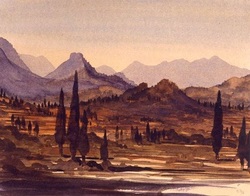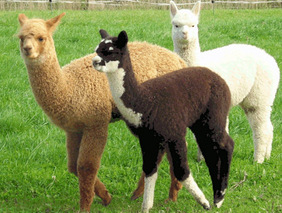An exciting time... Just had a first glimpse of some of the TAG artworks being produced. More soon. ~James
0 Comments
Continue to have thoughts about being able to 'walk through' microworld landscapes. AFM data lends itself to this possibility, since the image is essentially a collection of height, width and breadth (x,y,z) info. Might have words with the 3d simulation and animators within the University. It would be great to 'climb on a virus' - a variation of the BBC Walking with Dinosaurs series a while back (where University of Portsmouth made it's contribution). This may not be part of the current project, but something to think about. ~James Taking it easy in Shenandoah National Park, VA, USA, Nov 2012.
Printing the AFM images taken from Lynda's hair. ~James
Jacqui L taking some photos of some of the artworks currently being produced by TAG during today's session. ~James
Imaged a few samples of alpaca and cat hair to aid Jacqui S's musical interpretations. ~James
 I watched an interesting programme on TV last night 'Royal Paintbox', where Prince Charles discussed his paintings and artworks produced by royalty over the years. A number of phrases particularly stood out: 'art encourages you to look and observe', 'not a record [like a photograph], but more meaningful', 'a deeper
level, almost meditative', 'concentration is meditation really', 'a quality of soulfulness', 'things beyond the surface', 'shut everything else out and enter a different world', 'then come out of it, back into the real world.' ~James
It's been a busy time, but I thought I should provide a summary of the Portsmouth visit that happened last week before some important points disappear from mind. The idea was to fit the visit in during the Easter break whilst it was relatively quiet. Unfortunately, Jacqui L and Sandie could not attend due to a timetable clash and a chest infection.
I thought I'd start the visit with a lecture-type chat where I would go through the hair images of the TAG members that I had imaged in March. The slides from the PowerPoint presentations are shown elsewhere in this blog. The coach arrived at Portsmouth slightly earlier than expected and so whilst waiting for Lynda and Jacqui S, we chatted about the project in general. It became obvious that some of the group were finding the idea behind the project a bit difficult to grasp. I said I'd go through this again during the presentation. I spoke about the website and the blog section designed to report the latest news and provide a historical record etc. I also handed around a contact list where TAG members were invited to provide their email addresses to encourage further two-way communication. By this time Lynda and Jacqui S had arrived. I gave out the folders, marked with the TAG members initials, containing the images but said not to open the them just yet - everything was on the screen. I reassured the group that the images and notes about them were included in the pack and so it wasn't necessary to write everything down, although pens and paper were provided. I did say that I would be grateful if they could remove the feedback sheet from the back of the folder, answer the two questions and leave it in the lab before they went (see feedback response elsewhere in this blog). I started the presentation with an overview of the project and that the main idea was for artists to 'interpret' the AFM images, both those given out today and previously, in a way that was personal to them. This could be done in a scientific/direct way, such that the images might be 'seen' in the artworks, or in a deeper, personal way, facilitated by the fact that the latest images were taken directly of them. I stressed that the second method was preferable, although both would fit the public understanding of science remit. Any artwork is 'allowed', as long as the micrograph(s) had provided some kind of inspiration. I mentioned that I imagined that in the exhibitions to come, some caption text might be positioned next to the artwork offering some explanation. This might provide the greatest source of public understanding after the observer had been drawn in. I also mentioned that there were different levels of teaching science to the public: in this case, me to TAG members and then TAG members getting 'in on the act' via their interpretative artworks. I think I got the point across. I then asked the group to open their folders, remove the envelope and discretely open it to reveal their 'code numbers'. These were to allow the PowerPoint commentary of the images to proceed without pride, violence or remorse. I did make a strong point of mentioning, however, that the images presented were not representative of that hair and even less so a whole head of hair; just a few micrometres along the hair, a different story might be told! I talked about the importance of adequate sampling in science and that I didn't ask for the hairs to be cleaned, but said that these images were nonetheless obtained from them and so might provide some source of reflection. I went through the images one by one going through their structural features and significance. Conscious of not wanting to bore people to tears with holiday photos, I cut the presentation in two by only showing one root image and one tip image, although two of each were provided in the pack. There was still quite a bit of similarity between the images and in summary, I concluded the hair samples followed the basic fragmentation patterns seen before with hair samples (see conclusion on the PowerPoint presentation). In doing the scanning, however, some interesting structural features were seen and I mentioned that these were being discussed with fellow scientists - there is still much to learn about hair! We had a Questions & Answers session at this point. Questions included:
After this, we retired to the microscopy suite. I showed the group the various microscopes: light ('normal'), fluorescence, live cell imaging and the all-important(!) AFM (and we briefly discussed the scanning electron microscope, located in the neighbouring building). I always like to discuss the AFM probe in terms of a record player stylus. I then asked the group whether they wanted to scan the silver fox, hippopotamus tail, elephant, alpaca, Asiatic lion - male or female - or the flying fox: I assumed that they might have been a bit fed up with hair by this stage. The hippopotamus tail won. The group were surprised to see the thickness of the 'hair' and we had some difficulty cutting it with scissors, even with the special hippopotamus tail hair-cutting scissors. We landed the tip carefully, trying to avoid crashing it into the hippo - never a good thing. The group seemed very interested and many of them got out cameras. The questions kept coming. Lynda and Jacqui S provided further examples of artistic interpretations: Hockney, Holst and Hebrides Overture. We then just had time to scan a bit of the silver fox, with associated humour, before it was time to leave for the coach. A good time, albeit slightly surreal, was had by all. ~James Did some imaging of root and tip regions of Lynda's hair to aid her artistic interpretations. ~James
Using the literal/self model, which has its restrictions, proposed in a previous blog entry to aid/classify the interpretation process, I thought about some possible artworks that could be produced - mainly at the literal ('science-end') of the spectrum of interpretations. I might have a go at some of these myself using the micrographs directly or by manipulating photographs. The ideas are listed below. They may also serve to give further inspiration to others; I haven't really thought about the 'self-type' interpretations, although some of these ideas may provide pointers to this realm.
~James |



 RSS Feed
RSS Feed